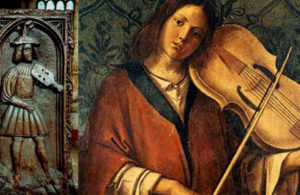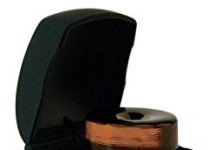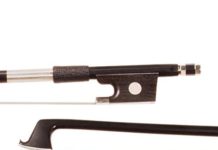The violin has long been one of the most prominent musical instruments in use, and some would argue that this instrument is the third most popular musical instrument after the piano and the guitar. Every day, people admire the distinct, yet melodic sounds the violin produces. The violin’s vibrant and graceful tones have become a favorite among musicians and non-musicians alike. However, few people have the slightest idea of how this instrument was invented.
As far as we know, this instrument developed over the course of centuries. If you observe closely, many Renaissance painting and frescos clearly show early incarnations of the violin. As we will learn later in this article, no one really knows who constructed the first violin.
In this article, we are going to take an in-depth look at the roots of our favorite instrument. We are going to trace the history of the violin from antiquity, up until its modern versions and variations.

The Term, ‘Violin’
Before we embark on a journey to learn the history of the violin, however, it is essential that we get acquainted with the instrument itself. The violin is a wooden, stringed instrument, with a hollow wooden body. It is regarded as the smallest and the highest-pitched instrument in the string family.
The term was first used in the 1570’s by the English, and comes from the Italian word, “violino,” which is a diminutive of the viola. The viola, in turn, came from the Old Provencal word, “viola,” which came from the Medieval Latin word, “vitula.”
You may hear the violin frequently called a fiddle; they are one and the same. The term “fiddle” means “a stringed musical instrument,” and was first used in the late 14th century by the English. Nowadays, it refers less to a proper violin, and more to a style of playing. Like “violin,” however, the word also comes from the Latin, “vitula.”
In Antiquity
Ibn Khurradadhbih, a Persian geographer of the 9th century, was the first person to cite the bowed Byzantine lira, which, according to Khurradadhbih, was a typical instrument of the Byzantines. The instrument spread throughout Europe in a westward wave. By the 11th and 12th centuries, European writers began using both the terms “lira” and “fiddle” to refer to the bowed instrument. In the meantime, the rabab, which was the equivalent of the lira in the Islamic Empire of the time, was introduced to Western Europe, possibly through the Iberian Peninsula.
Slowly, the bowed instrument spread throughout Europe, allowing the Europeans to create their own version of the lira. Over centuries, countries in Europe developed two distinct bowed instruments: the relatively square-shaped instrument known as the “lira da braccio,” and the other one, an instrument with sloping shoulders that held between the knees, and is known as the “lira da gamba.” Both of these terms are of Italian origin.
Emergence of the Violin
The first makers of the violin may have borrowed from various developments of the early bowed instruments, including the Byzantine lira and the rebab. It is unclear among historians who made the first violin, but the first record of an instrument that resembles a violin comes from the paintings of Gaudenzio Ferrari. His painting, called, “Madonna of the Orange Tree,” for instance, displays a cherub playing a bowed instrument that looks a lot like the early forms of the violin. Ferrari’s painting is just one of the many early paintings and frescos that depict the now-familiar structure of the violin. These early images of the violin, even though it only had three strings, could be seen in Italy at around 1530.
Early Makers of the Violin
The oldest surviving violin, known as the “Charles IX,” was built by Andrea Amati in 1564. Aside from Amati, there were also various makers who developed violins between the 16th century and the 18th centuries. Some of the more prominent names included:
- The Michelli family of Italy including Zanetto and Pellegrino Michelli
- The Bertolotti da Salo family of Italy, who specialized in violin and double bass
- Gasparo Bertolotti, also known as Gasparo da Salo, is the most famous member of the family
- The Guarneri family of Italian violin makers. Some of the most famous members of the family include Andrea Guarneri, Guiseppe Giovanni Battista Guameri, and Pietro Mantua
Transition from The Baroque Style to the Modern Form
As the centuries progressed, so did the violin. Starting the 16th century, several modifications were made to the violin. For instance, the fingerboard was lengthened in order to increase the upper range of the instrument. Moreover, the fingerboard was also tilted a little more, allowing an increase in volume, since larger orchestras were becoming more and more popular.
The bass bar was also made lighter. Classical luthiers had nailed and glued the instrument necks and the upper block of the body before being able to glue it on the soundboard. In the early 19th century, Louis Spohr invented the chinrest.
Modern Incarnations of the Violin
Just as all things modernize, so did the violin. The Stroh violin, for instance, uses mechanical amplification to boost the sound volume. It has the overall look and shape of an old-fashioned gramophone, with a long, trumpet-like appendage.
The electric violin also emerged in recent times. Not only does it look attractive, the electric violin has recording and playback features. Some electric violins even have a hollow body of holes, allowing the instrument to be played without sound amplification.
Final Thoughts
The violin has gone through a lot of changes over the course of time, yet its sweet and vibrant sound is still a favorite among musicians and non-musicians alike. Being a significant musical instrument, especially in the orchestra, the violin should be appreciated well. One of the ways of the best ways of showing appreciation towards the instrument is by knowing its history.
Table of Contents






